Chapter 7 Using Window Manager Enhancements
Window Manager Enhancements consist of three separate applications. They are:
These three applications provide the ability to manipulate workspaces and windows from the different applications depending on the tasks you want to perform. Graphical Workspace Manager allows for changes in workspaces and windows. The Window List concentrates on the manipulation of windows. Finally, the Workspace Manager controls the number of workspaces, whether or not the Workspace Switch Area appears on the Front Panel, and the ability to restore the default values.
Graphical Workspace Manager
Graphical Workspace Manager enables you to operate a workspace "control panel". This panel displays a window containing a miniaturized picture of each workspace on the desktop. Workspaces may be created, deleted, renamed, tiled, or cascaded. Application windows may be moved (within or between workspaces), terminated, minimized, or maximized.
Figure 7–1 Graphical Workspace Manager Main Screen
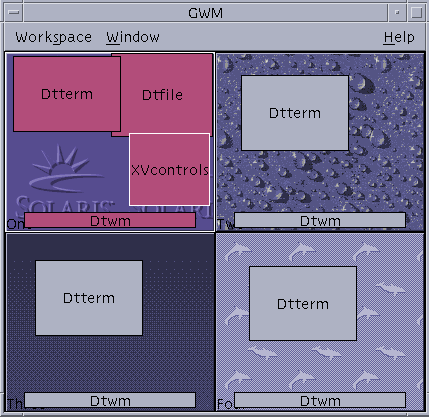
Starting the Graphical Workspace Manager
The Graphical Workspace Manager can be started either from the Desktop or from the command line.
To Start the Graphical Workspace Manager from the Desktop
-
Right-click on the Desktop to open the Workspace menu.
-
Choose Applications.
-
Choose Application Manager.
-
Double-click Desktop_Apps.
-
Double-click GWM.
To Start the Graphical Workspace Manager from the Command Line
Type sdtgwm at the command line.
Graphical Workspace Manager Tasks
There are a number of tasks that you can perform using Graphical Workspace Manager:
Figure 7–2 Graphical Workspace Manager – Workspace Menu

To Add a Workspace
-
Choose Add Workspace from the Workspace menu.
-
Enter a name in the Add Workspace dialog box.
-
Click OK.
To Delete a Workspace
-
Choose Delete Workspace from the Workspace menu.
-
Choose the workspace to be deleted from the submenu.
To Rename a Workspace
-
Choose Rename from the Workspace menu.
-
From the submenu, select the workspace to be renamed.
-
Enter the new name in the Rename Workspace dialog box.
-
Click OK.
To Switch to a Different Workspace
-
Choose Switch to Workspace from the Workspace menu.
-
From the submenu, select the workspace to which you want to switch.
To Cascade All Windows in a Workspace
This task executes in the current workspace.
Choose Cascade All Windows from the Workspace menu.
To Tile All Windows in a Workspace
This task executes in the current workspace.
To Open the Options Dialog
Choose Options from the Workspace menu.
For further information on the Options Dialog, see Graphical Workspace Manager Options Dialog.
Figure 7–3 Graphical Workspace Manager — Window Menu
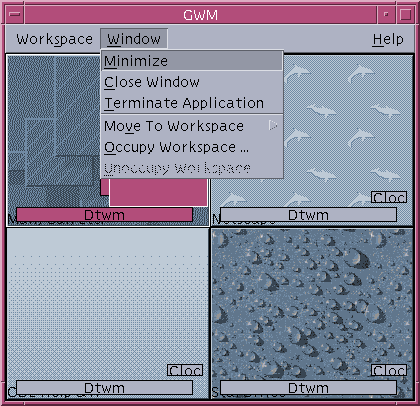
To Minimize a Window
To Close a Window
-
Select a window in Graphical Workspace Manager.
-
Choose Close Window from the Window menu.
-
(Optional) If the window you are closing is the only window that contains the application, a confirmation dialog will appear. Click OK, if you want to continue with closing the window.
To Terminate an Application
-
Select an application window in Graphical Workspace Manager.
-
Choose Terminate Application from the Window menu.
-
In the confirmation dialog box, click OK.
To Move a Window to a Different Workspace
-
Select a window in the Graphical Workspace Manager.
-
Choose Move to Workspace from the Window menu.
-
From the submenu, choose the workspace to which you want the window to move. You may also choose All Workspaces.
To Occupy Workspace(s)
-
Select a window in the Graphical Workspace Manager.
-
Choose Occupy Workspace from the Window menu.
-
Choose the workspace(s) from the submenu.
Multiple workspaces can be selected by pressing the Control key and selecting the additional workspaces.
-
Click OK.
To Unoccupy Workspace
Graphical Workspace Manager Options Dialog
The Graphical Workspace Manager Options dialog box contains a number of options that can be set. They are:
Figure 7–4 Graphical Workspace Manager Options Dialog Box
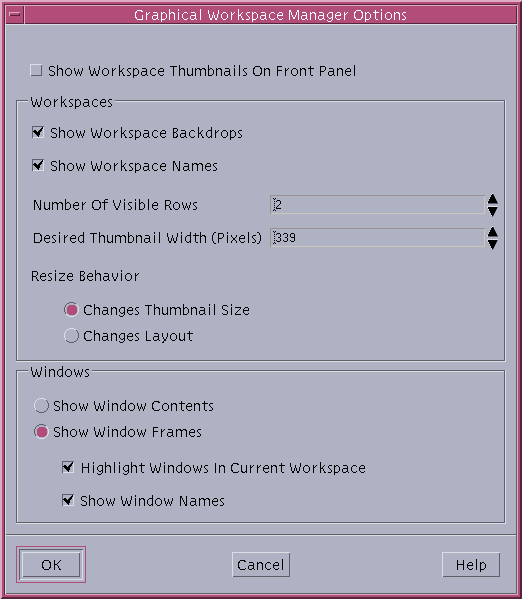
-
Show Workspace Thumbnails On Front Panel – Determines if the Graphical Workspace Manager workspace images will appear on the Front Panel.
-
Show Workspace Backdrops – Determines if the actual workspace backdrops will be shown in the Graphical Workspace Manager.
-
Show Workspace Names – Displays the workspace names in the thumbnailed workspaces of the Graphical Workspace Manager.
-
Number of Visible Rows – Enables the setting of the number of rows used to display the open workspaces of the Graphical Workspace Manager.
-
Desired Thumbnail Width (Pixels) – Sets the width, in pixels, of the workspace display in the Graphical Workspace Manager.
-
Changes Thumbnail Size – Specifies that a resize of the Graphical Workspace Manager will actually increase/decrease the size of the Graphical Workspace Manager main window, thus changing the size of the workspace thumbnails.
-
Changes Layout – Specifies that a resize of the Graphical Workspace Manager will only change the layout of the workspace thumbnails within the Graphical Workspace Manager.
-
Show Window Contents – Causes window images to be grabbed and displayed.
-
Show Window Frames – Window images will not be grabbed. Blank boxes will be displayed.
-
Highlight Windows In Current Workspace – The windows in the current workspace will be displayed in the desktop highlight color. This option is only available if Show Window Frames is selected.
-
Show Window Names – The command name of the window will appear in the window. This option is only available if Show Window Frames is selected.
Window List
The Window List displays information about all windows across the CDE workspaces. Once launched, the window list will be updated in a dynamic fashion.
Figure 7–5 Window List Main Screen

The windows can be sorted in one of the following orders:
-
Workspace Name
-
Window State
-
Application Name
-
Window Title
Starting the Window List
The Window List can be started either from the Desktop or from the command line.
To Start the Window List from the Desktop
-
Right-click on the Desktop to open the Workspace Menu.
-
Select Applications.
-
Select Application Manager from the Applications submenu.
-
Double-click Desktop_Apps.
-
Double-click Window List.
To Start the Window List From the Command Line
Type sdtwinlst at the command line.
Performing Window List Tasks From the Window Menu
There are a number of tasks that you can perform using the Window List. They are:
-
To Go To a Window – Goes to the selected window and gives it focus. If it is in another workspace, you are moved to that workspace.
-
To Get a Window – Moves the selected window from whatever workspace it is in to the one you are currently in and gives it focus.
-
To Lower a Window in the Stack – Lowers the selected window to the bottom of the window stack.
-
To Minimize the Selected Window(s) – Minimizes the selected window(s).
-
To Close a Window – Closes the selected window(s). If the window to be closed is the only window associated with an application, a confirmation dialog box appears.
-
To Terminate an Application – A confirmation dialog box appears and all windows associated with that application are closed.
-
To Move the Selected Window(s) Into Another Workspace – Moves the selected window(s) to the specified workspace.
-
To Occupy the Selected Workspace – Opens the Workspace Chooser dialog box and places the selected window in the workspace chosen from the list.
-
To Unoccupy the Selected Workspace – Removes the selected window from the current workspace. If this is the only workspace the selected window resides in, this option is greyed out.
-
To Cascade all Non-minimized Windows in a Workspace – Cascades all windows in the current workspace.
-
To Tile all Non-minimized Windows in a Workspace – Tiles all windows in the current workspace. Tiling can be horizontal or vertical.
Figure 7–6 Window List Window Menu
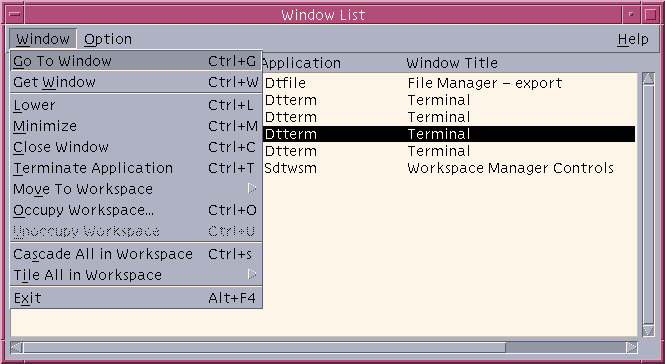
To Go To a Window
Note –
Depending on the setting of the Window List Options, you may be able to double-click on the Window List entry and move to the workspace that contains the selected window or have the window move to the current workspace. Refer to To Set the Action of a Double-click on a Window Entry.
To Get a Window
-
Select a window from the Window List.
-
Choose Get Window from the Window menu.
Window appears in the current workspace.
To Lower a Window in the Stack
To Minimize the Selected Window(s)
To Close a Window
-
Select a window(s) from the Window List.
-
Choose Close Window from the Window menu.
-
(Optional) If the window being closed is the only window that contains a given application, a confirmation dialog box will appear. Click OK, if you want to close the window and terminate the application.
To Terminate an Application
-
Select a window from the Window List.
-
Choose Terminate Application from the Window menu.
-
(Optional) If the window being closed is the only window that contains a given application, a confirmation dialog box will appear. Click OK, if you want to close the window and terminate the application.
To Move the Selected Window(s) Into Another Workspace
-
Select a window(s) from the Window List.
-
Choose Move to Workspace from the Window menu.
-
Choose a workspace or All Workspaces.
To Occupy the Selected Workspace
-
Select a window(s) from the Window List.
-
Choose Occupy a Workspace from the Window menu.
-
Choose the workspace you want the window to occupy from the Occupy Workspace dialog box.
To Unoccupy the Selected Workspace
To Cascade all Non-minimized Windows in a Workspace
This occurs only in the current workspace.
Choose Cascade All in Workspace from the Window menu.
To Tile all Non-minimized Windows in a Workspace
This occurs only in the current workspace.
Performing Window List Tasks from the Option Menu
There are two tasks that can be performed from the Option Menu. They are:
Figure 7–7 Window List Option Menu
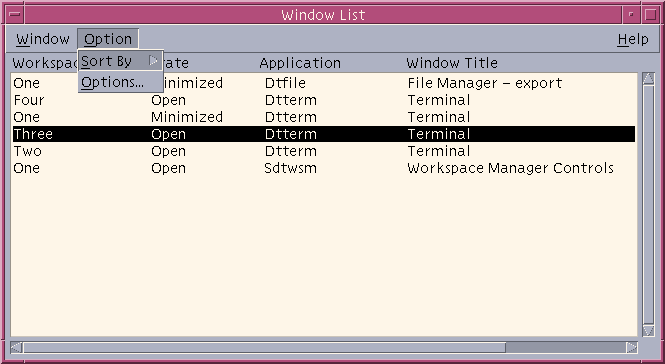
Sorting Options
Opening the Options Dialog
Select Options from the Option menu.
Window List Options
There are two options that you can change using the Window List – Options dialog box:
-
Show Column
-
Double–clicking on a window in the list
These two options allow the setting of which columns will appear in the Window List and what action will be taken when you double-click on a window item in the Window List.
Figure 7–8 Window List – Options Dialog
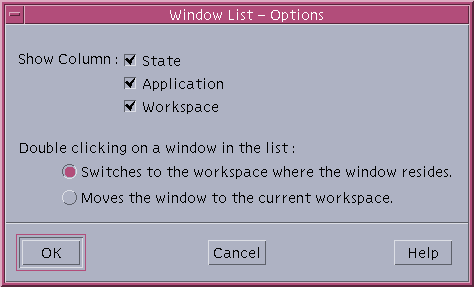
To Show Columns
-
Click the State, Application, or Workspace check boxes for that column to be displayed.
The lack of a checkmark means the column will not be displayed.
Note –The Window Title column will always be visible.
To Set the Action of a Double-click on a Window Entry
Window List provides the ability to select the effect of double-clicking a window entry in the Window List.
-
Click the Switches to the workspace where the window resides check box.
This has the effect of switching to the workspace that contains the selected window.
-
Click the Moves the window to the current workspace check box.
This has the effect of moving the selected window to the current workspace.
Workspace Manager
The Workspace Manager provides a Graphical User Interface (GUI) for controlling behavior and the number of workspaces. You will be able to add and delete workspaces using the slide bar. Workspace Manager enables you to show the Workspace Switch Area on the Front Panel instead of the workspace buttons. You will also be able to return to the default settings.
Figure 7–9 Workspace Manager Main Screen
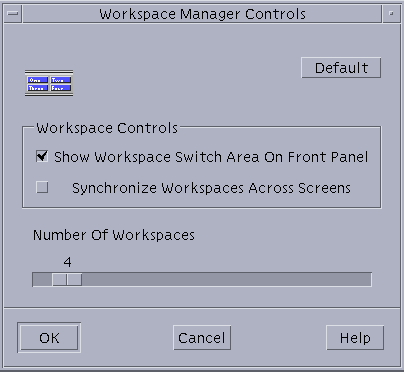
Starting Workspace Manager
You can start the Workspace Manager either from the Workspace Menu or at the command line.
To Start the Workspace Manager From the Desktop
-
Right-click on the Desktop to open the Workspace Menu.
-
Choose Applications.
-
Choose Application Manager from the submenu.
-
Double-click Desktop_Apps.
-
Double-click Workspace Manager Controls.
To Start the Workspace Manager From the Command Line
Type sdtwsm at the command line.
Using Workspace Manager Controls
There are a number of functions that can be performed using the Workspace Manager:
To Display the Workspace Switch Area on the Front Panel
To Synchronize Workspaces Across Screens
To Set the Number of Workspaces
-
Move the Number of Workspaces slide bar until the desired number of workspaces appears.
-
If the resulting number of workspaces is an addition, the new workspace icons will appear on the Front Panel.
-
(Optional) If the resulting number of workspaces is a reduction, the Workspace Manager Delete Workspace dialog box will appear. Click OK, if you want to delete the workspace(s).
To Restore the Default Settings
Click the Default button in the Workspace Manager Controls window.
- © 2010, Oracle Corporation and/or its affiliates
